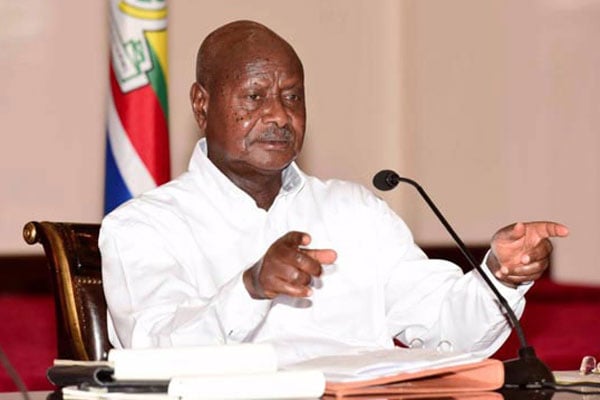Prime
How will Ugandans benefit from middle income status?

Farmers harvest tea from a garden Buhweju District recently. Experts argue that the magic bullet to Uganda achieving the middle income goal lies in increasing production and value addition. PHOTO | ZADOCK AMANYISA
What you need to know:
- Currently, only two partner states in the East African Community, Kenya and Tanzania, have a lower middle income status, with the latter only achieving it recently.
President Museveni has said Uganda is just shy of about $50(Shs175,375) to enter the coveted middle income status after several targets have eluded the country in the past decade.
Per Mr Museveni’s projections, Uganda will achieve the lower middle income in less than a year subject to the World Bank threshold, which is updated each year on July 1.
Currently, only two partner states in the East African Community, Kenya and Tanzania, have a lower middle income status, with the latter only achieving it recently.
A country’s income status is determined by looking at its Gross National Income (GNI) per capita, which is the dollar value of a country’s final income in a year, divided by its population.
President Museveni recently re-ignited his push for the country’s economy to move up the ranks from low income to higher-middle status by 2026. This means Uganda will have to jump to the stage Kenya and Tanzania are currently at and reach a level that has been achieved by less than 10 African countries. The less than 10 African countries in the category Mr Museveni seeks to catapult Uganda include South Africa, Namibia, Botswana, Equatorial Guinea and Mauritius.
Suffice to note that Uganda failed to achieve its low middle income status target by 2020, the card that had underlined Mr Museveni’s 2016 re-election campaign.
“Middle income is about the economy growing bigger compared to the population giving us high levels of GDP per capita. Please Google to get the thresholds for the different stages. If it happens, I doubt it will, Ugandans will benefit by having higher incomes at household level but also from a strong economy that would deliver the required services,” Mr Fred Muhumuza, an economist and policy analyst, says.
The World Bank defines a lower middle income economy as one with income per capita of between $1,046 (Shs3.7m) and $4,095 (Shs14.4m), while the higher middle income lies between $4,096 (Shs14.3m) and $12,695 (Shs45m).
Steps to take
On its middle income journey, Uganda will go through a number of steps. President Museveni’s projection of lower middle-income will require Uganda’s GNI per capita to be between $1,036 (about Shs3.6m) and $4,045 (about Shs14.1m).
To subsequently achieve the upper middle-income, Uganda’s GNI per capita must be between $4,046 (about Shs14m) and $12,535 (about Shs44m). To achieve the coveted high-income, Uganda’s GNI must be $12,696 (about Shs44.5m) or more.
Per capita income is calculated by dividing the country’s total GDP by the population. The measure assumes that the total wealth of a country is equally distributed across its population. Ideally, every Ugandan would be earning Shs3.7m and above per year.
But how would attaining status address the economic issues such as household incomes, unemployment, access to capital, infrastructure development, and access to social services.
At least 2.4 million people in Uganda have been pushed into poverty due to the Covid-19 pandemic and the associated measures to contain it, according to a recent Oxfam report.
The Oxfam report titled ‘The Inequality Crisis in East Africa: Fighting Austerity and the Pandemic’ places Uganda among the world’s 40 most unequal countries. Together with South Sudan and Rwanda, Uganda leads the pack in East Africa of the countries with the highest level of inequality.
Prof Augustus Nuwagaba, an economist, in an interview, says for a liberal economy such as Uganda where much wealth is concentrated in a few hands, per capita income is not the best measure for inclusive growth.
“This would mean Uganda’s wealth is divided equally, but as you can see, it is a very naive way of calculating livelihood because a few people own this money. So it is just a statistic, it is very far from reality. Income is concentrated in the hands of a few people and others are theoretically made rich,” he said.
He argues that there is no better indicator yet. Borrowing from the social democracies in Europe, Prof Nuwagaba says attaining middle income status would benefit the country if there is progressive taxation, where the more wealthy people pay more taxes, which is then used to improve social services for all.
Prof Nuwagaba says Uganda stands to lose certain benefits such as concessional borrowing and grants from the World Bank, and the International Monetary Fund (IMF).
“The organisations, which categorise countries, will say Uganda is now rich, so there are certain benefits we shall not get such as withdraws from the Special Drawing Rights, borrowing from IMF…,” he adds.
According to the 2022/2023 National Budget Framework Paper, Uganda plans to finance Shs5.5 trillon of its budget through external financing.
To achieve the President’s aspirations means doing 20 years’ worth of work in less than five years. According to the National Planning Authority (NPA), Uganda had planned to become an upper middle income country by 2040 as spelt out in the Uganda Vision 2040. The Vision sets out to achieve a per capita income of $9,500 (Shs33.4m), as well as improving the wellbeing of all Ugandans commensurate to upper middle income standards, to be realised through the implementation of the five-year NDP III. Attempts to get further clarification from NPA were futile.
According to Prof Nuwagaba, Uganda’s growth is undermined by the population growth rate.
“If the population reduces, even if GDP remains the same, the per capita income will increase. Even if the GDP increases and population increases at a higher rate, the per capita income will reduce,” he argues.
He adds that the magic bullet lies in increasing production, and value addition, which will create jobs, increase exports, and save the country more money.
“It is not enough to have higher-income status. It is important to consider the distribution of wealth so that there is inclusive growth…the country should know where growth is coming from. Most of the growth is coming from telecommunications and banking. It should have been agriculture, which employs 76 percent of the people. So even if there is growth, it is exclusive and jobless,” Prof Nuwagaba explains.
To achieve and maintain the middle-income status in Uganda, researchers from Economic Policy Research Centre (EPRC) argue that it is crucial to build a stable middle class in the country. Policy, they say, should target breaking the fragility of the middle class, and achieving a more resilient one, by focusing on the transition of those in the floating category to lower and upper middle-class categories. Thus, investing in the drivers of middleclass change such as organised urbanisation. About 8.3 million Ugandans (22 per cent of the population) are in the more rarefied world of middle-class.
Finance minister Matia Kasaija says the country failed to attain the lower middle income status in 2020 because of poor performance
“The main problem could have been poor performance by not implementing the projects that were supposed to be implemented,” he says.
Asked how attaining middle income status will improve the welfare of Ugandans, Mr Kasaija says the aspiration for the status is being accompanied by programmes such as the Parish Development Model to create a semblance of inclusive growth.
“The per capita is an average figure, it includes those who are poor, those who are very rich; it takes account of those who are far below and are only working for monetary terms. We are launching a new project, the Parish Development, which will reduce the number of people who work only for their ‘stomachs’. That presupposes that production will go up, and so will consumption, and we will be going to our middle income status,” he explains.
Mr Kasaija says when exploited, the oil resources will fill the resource gap, in case the country’s foreign aid reduces, when the country makes it to the middle income status.
African countries ranking
Higher middle income
Botswana
Equatorial Guinea
Mauritius
Namibia
South Africa
Lower Middle Income
Angola
Benin
Cote d’voire
Cameroon
Congo, Rep
Comoros
Cabo Verde
Ghana
Lesotho
Mauritania
Nigeria
Senegal
Sao Tome $Principe
Tanzania
Zambia
Zimbabwe




